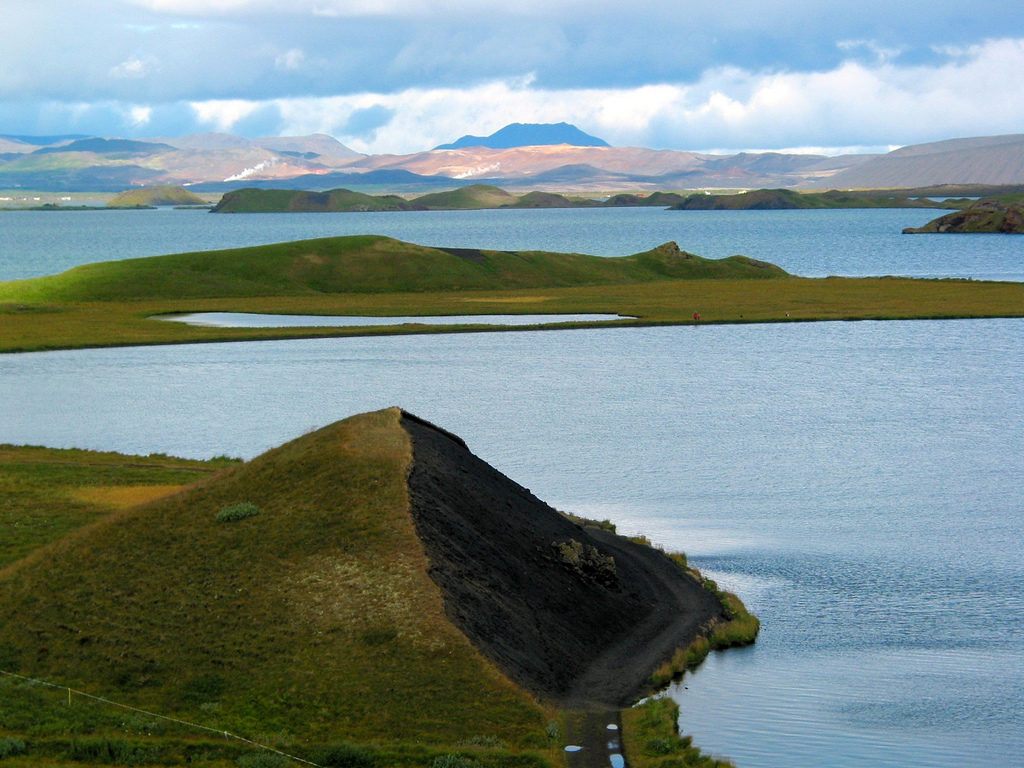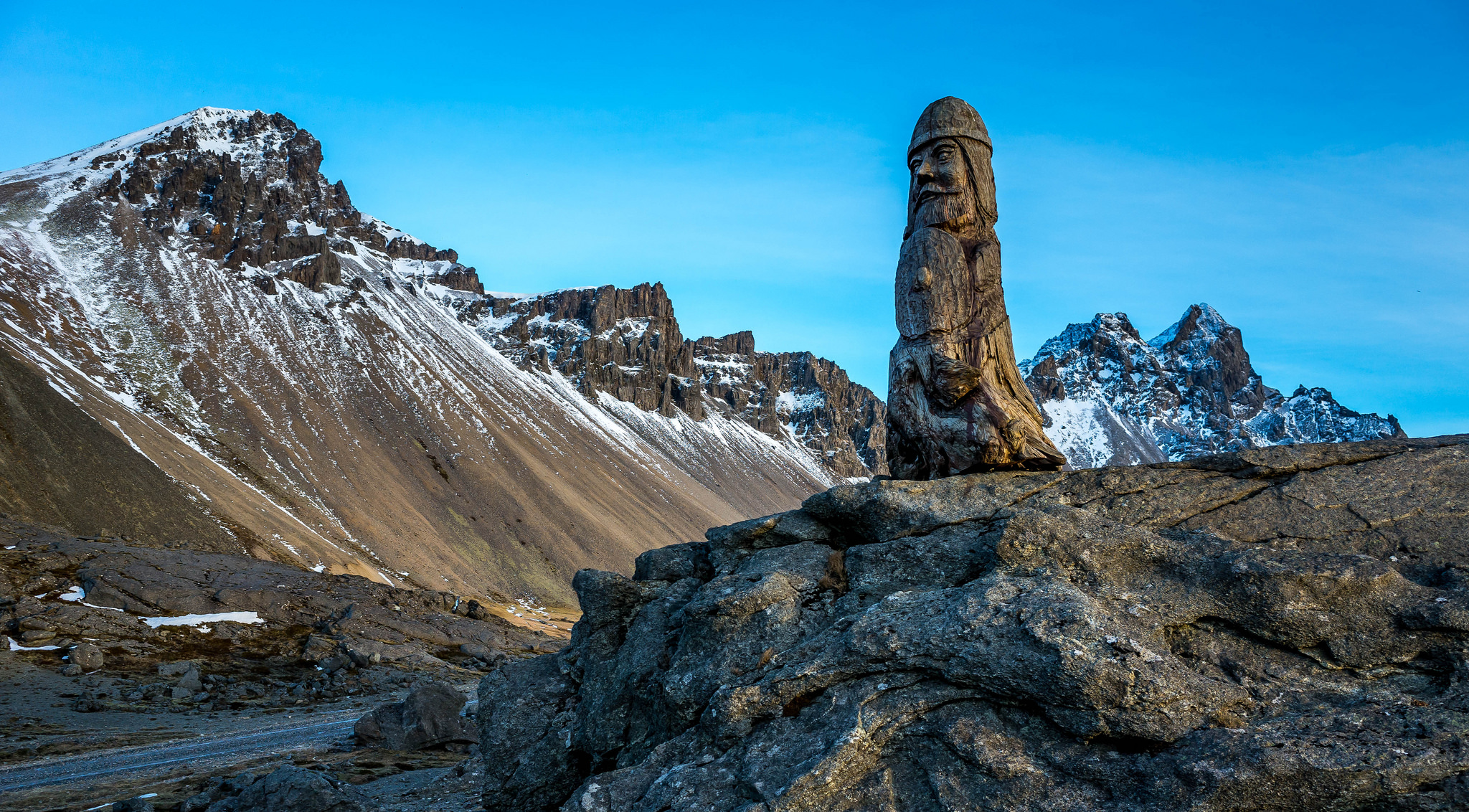Main image (c) sergejf
Reykjavík is the obvious starting point for visitors to Iceland, but if you want to get off the beaten track and explore a different part of the country’s Viking history, northern Iceland is a great option. It’s also a region of spectacular landscapes and geographical contrasts: active volcanoes, strange lava formations, geothermal pools and the largest waterfall in Europe.
Close to Lake Mývatn (which means ‘midge water’ – and watch out because at certain times of the year it definitely is), a large Viking Age chieftain’s hall was found at Hofstaðir. Nothing like it had ever been discovered in Iceland before. At first, it was identified as a pagan temple, but now archaeologists think that it was a big banqueting hall where pagan cult feasting took place. The strangest discovery was of 23 cattle skulls with butchery marks, indicating that they had been crushed between the eyes and then decapitated for maximum ‘blood spurt’ effect, perhaps as part of a dramatic pre-feasting ritual. The skulls were also weathered, which suggests that they were then hung on the outer walls of the hall for many years afterwards. The hall was established in about 950, at the height of the Viking Age and was abandoned around the middle of the 11th century, in the decades following Iceland’s conversion to Christianity.
On the south side of Lake Mývatn, another early farmstead is being excavated at Skútustaðir, which dates all the way back to the settlement itself. At one time during the Viking Age, a chieftain called Killer-Skuta, after whom the location is named, occupied this farmstead. Killer-Skuta even stars in his own Old Norse saga, called the Saga of the People of Reykjadal and Killer-Skuta. This is a saga full of bloody feuds and revenge killings: as his name suggests, Killer-Skuta is a hot-tempered man, who seeks vengeance for his murdered father, but ends up paying with his own life.
Northern Iceland also provides the setting for plenty more saga stories. In fact, it is possible to follow several dedicated ‘saga trails’ around the region, visiting locations where important (and often bloody) events took place. On the Sturlung Trail, visitors can learn more about the civil war that ripped apart 13th-century Iceland: start by pulling your hiking boots on and picking up a map in the tourist information centre at Varmahlíð.

Travelling west, you’ll then reach the region in which the Saga of the People of Vatnsdal is set. In the town of Blönduósi, you can even try your hand at a spot of embroidery and contribute to the ‘Vatnsdæla Tapestry Project’, which is bringing the saga back to life by turning it into a 46-metre-long tapestry. A few miles down the road there’s the abbey church and exhibition at Þingeyri, where some of the most important saga manuscripts were produced during the Middle Ages.
Northern Iceland is also home to some of the country’s quirkier Viking Age exhibitions. Skagaströnd is home to the marvellously named Museum of Prophecies, inspired by the 10th-century figure Thordis the Prophetess. Thordis was said to have lived on the nearby Spákonufell, or ‘Prophetess Mountain’. She crops up in several of the Old Norse sagas, and was said to be the foster mother of Thorvald, the country’s first native missionary. Not all of the Icelanders wanted to convert to Christianity, and two men composed a scurrilous verse about a bishop giving birth to nine children, all of whom had been fathered by Thorvald. Unfortunately, Thorvald didn’t see the funny side, and instantly murdered both the men.
The Museum of Prophecies is a bit more fun than Thorvald seems to have been: you can learn about all sorts of fortune telling methods, from runes to coffee cup sludge, and even have your own fortune told. After a hard day’s soothsaying, what better way to relax than in the nearby Grettislaug, or ‘Grettir’s Bath’, a geothermal pool said to have been used by the mighty but misunderstood saga outlaw Grettir Asmundsson. From the shore, you can look out to the island of Drangey where, according to his own saga, Grettir met his tragic end.
The Viking Age may have ended many centuries ago, but in Iceland, this is a past that still feels very present: in landscapes often unchanged since the first generations of settlers, in rediscovered pagan gods, in Medieval stories preserved in manuscripts, saga trails through the mountains and even in embroidered tapestries.
Eleanor Rosamund Barraclough is a lecturer in medieval history and literature at Durham University. Her most recent book is Beyond the Northlands: Viking Voyages and the Old Norse Sagas (2016).
